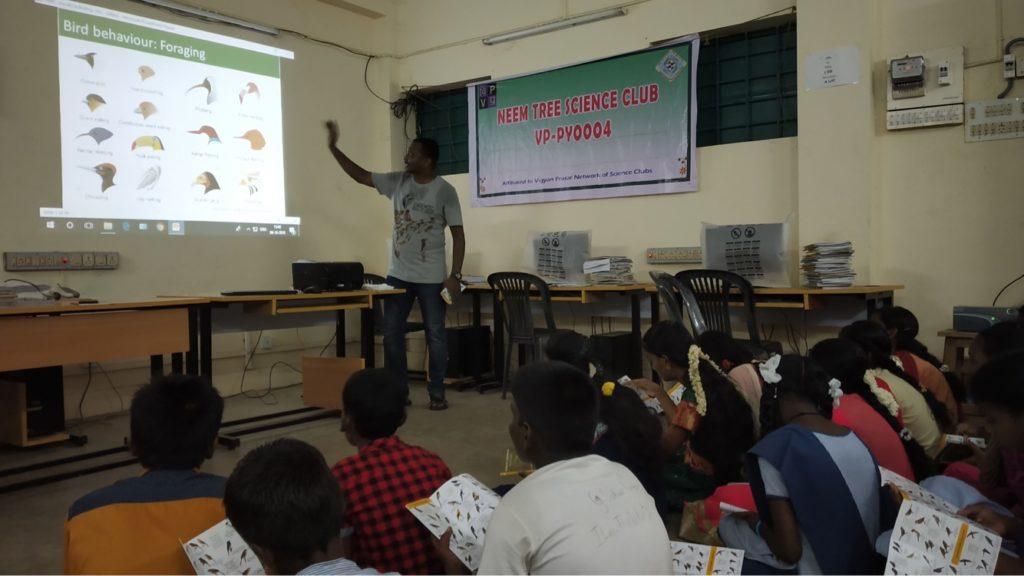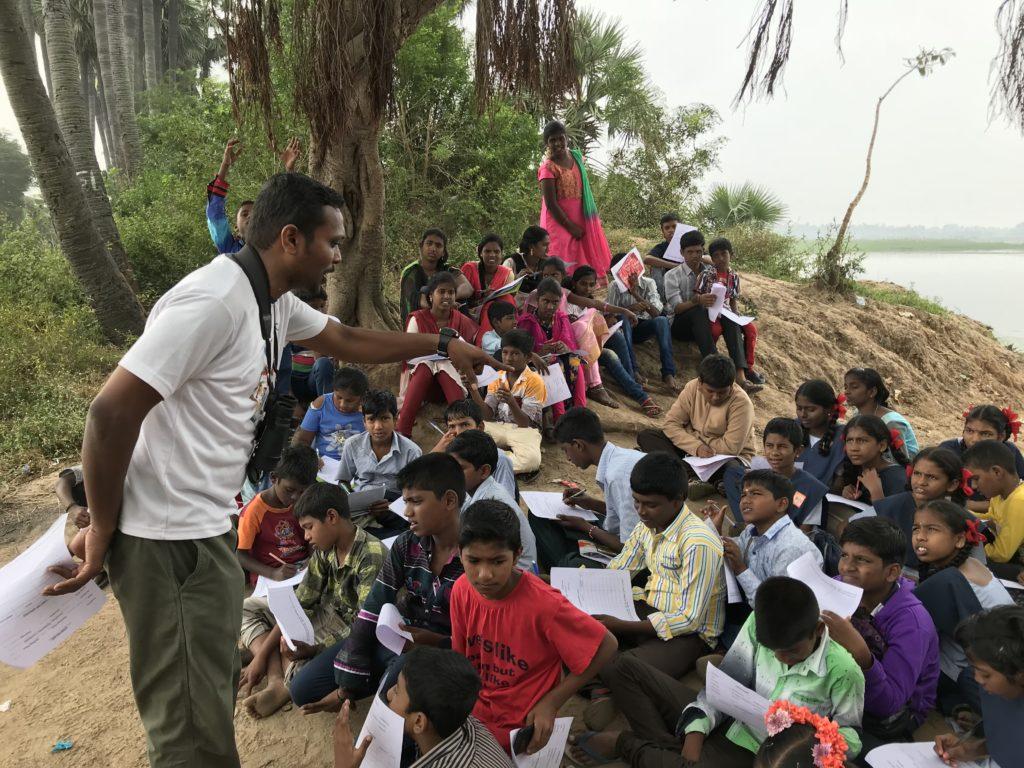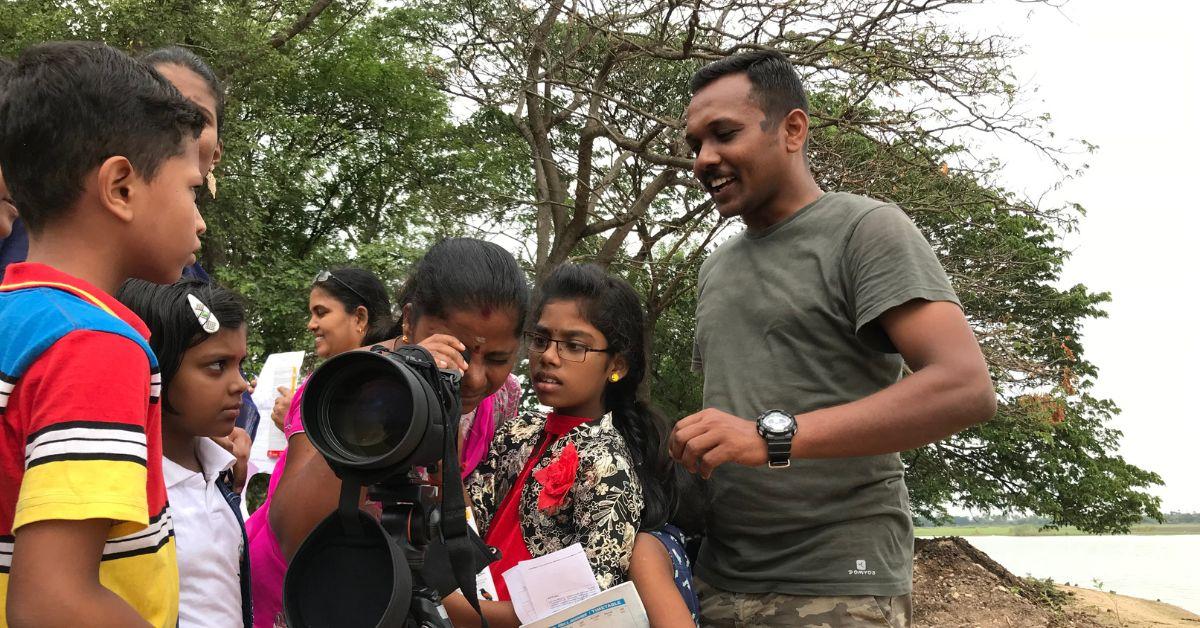Meet an Educator is a monthly series by Early Bird, where we feature the work of educators across India who are actively spreading the joy of birds and nature. This month’s featured educator is Surendhar Boobalan, a school teacher and birder from Puducherry. He popularises bird watching among students and the public by organising bird walks and talks.
Tell us about yourself
I am a school teacher and a birder from Puducherry. I have been watching birds since 2013. Currently I am involved in popularising bird watching among students and the public by organising bird walks and bird talks. I am proud to be a part of Tamil Birders Network, conducting the Pongal Bird Count and co-ordinating Campus Bird Counts in Puducherry every year.
Are you a birder? What about bird watching excites you?
I would like to share one of my favorite moments. Years ago, before I started bird watching, I saw an Indian Paradise Flycatcher male in a white morph with his long ribbon tail and his tail was moving in the wind and he was staring at me and flew off. It was the first instance I admired a bird in the wild. Even though I did not know the name of it at that time. The long tail, colour and flight attracted and surprised me. Still I recall that moment whenever I see an APF male.
When and how did you get interested in bird/nature education?
I love nature since my childhood as I was born and brought up in a village. But I got into birding accidentally ever since one my higher officials asked me to translate an English story book to Tamil, it had many bird names in it. Hence I was in search of Tamil names for those birds which led me to a meeting with Mr. Siva Ganapathy, a National Awardee Teacher and Birder. We discussed Tamil names and he took me to show Asian Openbills, introduced Red-wattled Lapwings – my first lifer. I have been watching birds since.

Then I had a chance to meet Mr. S.V. Ganeshwar, a voracious birder, in a bird walk organized by Pondicherry Science Forum. He explained the importance of listing and documenting birds, he taught me how to use eBird. Soon after that I attended the Tamil Birders Meet, wherein i learned about Early Bird and bird education.
What do you hope to achieve through your education work?
Through my education work I hope that I can make the students and public admire, enjoy and appreciate the natural wonders that occur in their immediate surroundings. By doing so, I believe that they can develop a sense of love and care for nature which makes them move closer to nature.
Why do you believe it is important for children to learn about birds or connect with nature?
I believe that it is important for children to learn about birds or connect with nature as they are the future generation and they must observe, cherish and live in nature. Consequently, they will taste the essence of nature and ultimately they raise their voice for nature and its conservation.
What tools or resources have helped you in teaching about birds?
Initially I used field guides to introduce birds. Later I purchased and used e-field guides in my gadgets as it gave me a zooming facility. Then I used observation sheets for species identification. After that I came up with model checklists based on eBird portal. Currently I am using the posters, activity sheets, Flashcards, pocket guides and games developed by Early Bird as well as the ppt developed by BirdCount India for bird talks and bird walks.

The game approach developed by Early Bird worked exceptionally well. Especially the Flashcards which attract people of all ages. Just before the pandemic I tried out the interactive posters with my students in class IV and V in a smart classroom, it was a much better teaching-learning experience.
Have you encountered a significant challenge as a bird/nature educator, how did you overcome it?
Yes, of course, as in any other profession. In the initial stage of my career it was harder for me to tackle teaching children compared to adults, as it was difficult to hold their span of attention. Later I introduced games and activities which I learnt from the Early Bird, which made all the children actively participate with sheer involvement irrespective of their age . Even the late bloomers showed their excellence, it suited all types of learners.
Approaching and involving government schools in bird related activities was a hectic task. I initially approached my friends who work as teachers in government schools to involve their students for the Campus Bird Count, they could not identify common birds so with a bit of hesitation and convincing – they agreed. I guided them by conducting sessions on common birds and also supplied pocket guides, posters, model checklists and other materials available online. Year after year, they have shown great improvement. Now they are doing bird watching and bird related activities in their schools.

Do share any memorable moment or experience you have had in teaching kids about birds/nature.
All the bird walks/talks which I’ve conducted are in my active memory because I am fascinated by the participant’s intriguing questions and sense of delight when they discover something for the first time while bird watching.
Before attending the Birding Buddy workshop I used to talk more, loading my listeners with a lot of information about birds. The kids used to listen, but my learnings from the workshop gave me an insight that the children must be given more space to observe, discuss and express their views in various art forms. Also, opportunities to exercise their learnings. The teacher should be a facilitator to kindle their thinking through thought-provoking questions.
At numerous instances in the classroom, my students have interrupted me to tell me about the bird calls that they hear outside the classroom. Then we all go to the veranda together and look out for the calling bird through the window, an exciting exercise for us all. The moment they spot the bird, their eyes twinkle with a spark and mouths gasp with curiosity.

We have spotted Koels, sunbirds, mynas, shikras, coucals, babblers, flowerpeckers and crows. At that time I was not aware of ‘My Bird Attendance Sheet’ by Early Bird; else I would have used it.
Have you noticed any changes in your learners after they received exposure to birds and nature-based learning?
Yes, certainly! My students used to shoo away the crows, but now they observe their behaviour, flight, etc. There were instances when my students killed millipedes in the classroom but now they let them go or pick them up carefully and release them in the garden. Moreover some students have started watching birds from their neighbourhood, they come to me frequently asking for help with descriptions to identify the birds that they see in their surroundings. I don’t reveal the answer easily but guide them to use the pocket guide / field guide.
What message would you have for your fellow educators, or somebody starting out in their nature education journey?
Each and every time you conduct a session, surprise the participants with fun filled games and activities like chinese whisperer, memory game, nature bingo, bird attendance and more! From my experience, I believe that conducting multiple sessions for a small targeted group is much more productive than engaging larger groups one single time. I request you to repeatedly focus on a ‘small’ targeted group.

